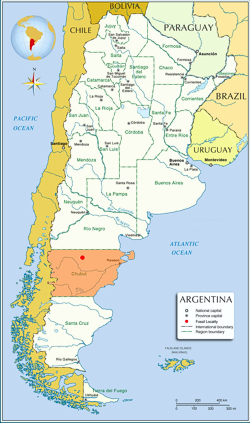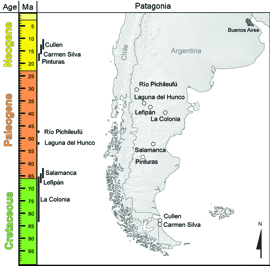 The Laguna del Hunco paleobiota is preserved in multiple fossil localities found in the Tufolitas Laguna del Hunco of northwestern Chubut Province, Argentina. The biota consists of a diverse assemblage of fossil plants, insects, and vertebrates preserved in sediments that were deposited in an ancient lake situated in a volcanic caldera. The flora is estimated to be about 52 million years old, or early Eocene in age, based on radioisotopic dating of volcanic sediments associated with the fossil deposits.
The Laguna del Hunco paleobiota is preserved in multiple fossil localities found in the Tufolitas Laguna del Hunco of northwestern Chubut Province, Argentina. The biota consists of a diverse assemblage of fossil plants, insects, and vertebrates preserved in sediments that were deposited in an ancient lake situated in a volcanic caldera. The flora is estimated to be about 52 million years old, or early Eocene in age, based on radioisotopic dating of volcanic sediments associated with the fossil deposits.
While the Laguna del Hunco localities occur today in a dry and sparsely vegetated landscape, in the Eocene the climate was moist, rainfall was high, and temperatures were moderate. The paleoflora includes ferns, conifers, and flowering plants, many of which have not yet been formally described. Preliminary work on the flora indicates that it has interesting biogeographic connections to distant modern regions, including the tropical flora of Australasia (especially New Guinea), the neotropical flora, and the temperate southern hemisphere flora.
Research on the Laguna del Hunco flora covers aspects of its context, ecology, biogeography, and systematics (classification and evolutionary relationships of plant groups).
Gandolfo Lab Research
Study of the Laguna del Hunco flora is a collaborative project, with different teams of researchers taking the lead on different components. In the Gandolfo Lab, Dr. M. A. Gandolfo is spearheading efforts to understand the systematics of the angiosperms—or flowering plants—based on reproductive material, which in the angiosperms including flower buds, flowers, fruits, seeds, and groupings of these structures (known as inflorescences for flowers and infructescences for fruits). Often, these structures are the most important for understanding the evolutionary relationships of flowering plants, and can give important clues to their biology.
Field Work
An important component of our research is collecting new fossils from the field. The Laguna del Hunco localities are incredibly productive, and new collections increase the chances that new species will be discovered, or new specimens that show previously unknown characteristics of known species will be found. For instance, it has been known for some time that the genus Eucalyptus—the Australian gumtree—is present in the Laguna del Hunco flora; it is represented by fossil leaves, fruits, and infructescences. During our 2009 field season, however, our field team also discovered several specimens of Eucalyptus buds and flowers. These new finds allowed us to study the structure of the buds, and we finally determined that they belong to a large subgroup of Eucalyptus that was previously thought to be younger than the Laguna del Hunco flora.
Lab Work
Much of the detailed work involved in describing and understanding species of fossil plants takes place in the lab. We employ many traditional methods of paleobotanical study, such as making observations, describing fossil species, and comparing fossil species to living plants, in order to understand the plants that we find in the field. In addition, we use modern analytical techniques to attempt to gain a more precise understanding of the evolutionary relationships of fossil and living plants.
Other Paleofloras
(Youngest-Oldest)
- Cenozoic Paleofloras
- Cullen (middle Miocene)
- Carmen Silva (Miocene)
- Pinturas (late-early Miocene)
- Río Pichileufú (early-middle Eocene)
- Laguna del Hunco (Early Eocene)
- Salamanca (early Paleocene)
- Cretaceous Paleofloras
- Lefipán (Maastrichtian- 65.5-66 myo)
- La Colonia (Campanian to Maastrichtian)
Laguna del Hunco Information
Copyright © 2020 · All Rights Reserved
